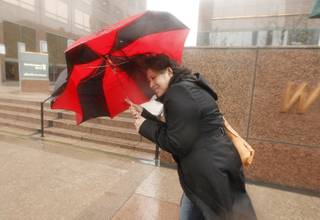
Damian Dovarganes / AP
Volunteers fill sandbags in the City of Glendora, Calif., Thursday, Feb. 27, 2014, in preparation for possible flooding.
Friday, Feb. 28, 2014 | 10:11 a.m.
LOS ANGELES — The first wave of a powerful Pacific storm spread rain and snow early Friday through much of California, where communities endangered by a wildfire just weeks ago now faced the threat of mud and debris flows.
Authorities in the foothill cities of Glendora and Azusa east of Los Angeles kept a wary eye on the barren slopes as rains moved through. Small debris flows covered one Glendora street but no property damage occurred, police said. Mandatory evacuation orders were issued for about 1,000 homes in the area on Thursday.
Numerous traffic accidents occurred on slick or flooded roads across Southern California, and a 10-mile stretch of Pacific Coast Highway west of Malibu was closed as a precaution against possible rockslides from a fire-scarred section of the Santa Monica Mountains.
In Los Angeles, rising water forced police to close major roads crossing the Sepulveda Basin. The flood-control area for the Los Angeles River on the San Fernando Valley floor is maintained as a wildlife refuge and recreation center but is otherwise kept clear of development.
Rain was also falling in the central coast counties, in the San Francisco Bay region and in the Central Valley. Winter storm warnings were in effect in the Sierra Nevada for heavy snowfall.
Forecasts called for the storm to last through Saturday in California, bringing some relief amid a long-running drought, and to spread east into similarly parched neighboring states. Phoenix was expecting its first noticeable precipitation in two months.
Around San Francisco Bay, the storm led to an urban and small stream flood warning, as rain in excess of a half-inch an hour moved in, according to the National Weather Service. Wet roadways and crashes slowed the morning commute, and there were isolated power outages.
In San Jose, a driver had to abandon his vehicle after attempting to drive through a flooded street and becoming stranded, police said. The driver was not hurt. Firefighters also pulled a man from swollen Coyote Creek near a homeless encampment. He was treated at a hospital for hypothermia.
Some arriving flights at San Francisco International Airport were delayed by more than four hours, according to the Federal Aviation Administration.
South of San Francisco, Half Moon Bay pumpkin farmer Chris Gounalakis worked in a soft drizzle to make sure his plowed fields weren't being eroded by a creek.
"Our land can start funneling into the creek, it's happened before. Then we end up losing our little precious land, and right now we do need every little bit," he said.
The storm's full force was expected to be felt later Friday morning, with possible thunderstorms and rains up to an inch per hour, the National Weather Service said.
On Thursday, mandatory evacuation orders were issued for about 1,000 homes in Glendora and Azusa, about 25 miles east of Los Angeles that sit beneath nearly 2,000 acres of steep mountain slopes stripped by fire in January. People were not forced out, but some residents quickly heeded the call.
"We have an hour to get evacuated," said Dana Waldusky as she hurried to evacuate the family home next to the burn area in Glendora. "We're just boarding up all our doors."
Waldusky, 22, said she, her parents and sister made sure they had important documents, photos, medicines and their toothbrushes packed.
The home survived the fire, which firefighters stopped 15 feet from their back fence.
"This time there's nothing you can do. You can't stop water," she said.
While concern was highest in the Glendora-Azusa area, meteorologists also posted flood watches for many other areas denuded by fires over the past two years.
Cities in Santa Barbara and San Luis Obispo counties were handing out sandbags in anticipation of heavy rain.
Even waterspouts offshore and small tornados were possible, the weather service said.
California's rain totals are far below normal and it will take a series of drenching storms to make a dent in a statewide drought that is among the worst in recent history.
The state Department of Water Resources took a new survey of the Sierra Nevada snowpack on Thursday and found the water content at only 24 percent of average for the date. The northern and central Sierra snowpack normally provides about a third of the water used by California's cities and farms.
Farmer Ray Gene Veldhuis, who grows almonds, walnuts and pistachios and runs a 2,300-cow dairy in the Central Valley's Merced County, welcomed the wet weather doubted it will rescue California from drought.
"This is actually getting back to normal rather than being abnormal," Veldhuis said in an interview Thursday. "It's kind of a blessing. Hopefully, they keep coming. If not, we'll deal with the hand we're dealt."
AP writers Martha Mendoza and Sudhin Thanawala reported from Northern California. Scott Smith reported from Fresno.


Join the Discussion:
Check this out for a full explanation of our conversion to the LiveFyre commenting system and instructions on how to sign up for an account.
Full comments policy